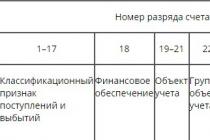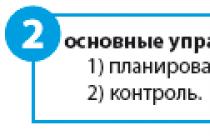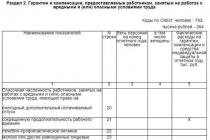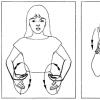When checking the correctness of spending of funds by the executors of a state contract and protecting the initial (maximum) price, representatives of the customer, along with contract documents and calculation materials, require justification of the amount of costs. Namely - to present technological maps, time sheets, standards for the consumption of raw materials, supplies, fuel, the use of machinery, equipment, etc. The justification of labor costs raises especially many questions.
Actually, labor costs depend on two factors: the average salary of the main performers and the labor intensity of the work.
The accepted salary depends on the level of wages in the industry and region. When determining the planned level of wages, the achieved level is multiplied by the consumer price index (CPI) and the index of changes in real wages. To confirm the level of payment by type of economic activity in your region, you can request a certificate from the Federal State Statistics Service.
How to justify labor costs or labor intensity? What labor standards should be applied?
To justify the labor intensity of time-based payment, you can use a convenient Timesheets broken down by project and employee category.
Labor intensity should not be confused with production.
Output determined by the volume of products produced (work performed) per unit of personnel. Production standards are established both in physical terms (pieces, kilograms, meters, etc.) and in monetary terms for a certain time of work (hour, shift, day, month, year). They are necessary for planning production potential and labor costs.
Labor intensity measured by the labor costs of working time for a certain volume of output in a specified time.
Hence the basic labor standards:
Production rate- this is a certain amount of work (in m2, cm3, etc., that is, in physical terms) or the number of units of production that an employee or group of employees must complete per unit of time under certain technological and organizational parameters. For example, an assembly fitter must assemble 2 products in an hour of work.
Standard time- the amount of working time that an employee or group of employees must spend to perform a certain job. For example, an assembly fitter must assemble 1 product in 30 minutes. Labor cost standards can be established for an operation, product, work, or set of works.
The work rate is divided into the time of work itself and the time of breaks
THE STATE DOES NOT REGULATE NORMS AND REGULATIONS IN THE FIELD OF LABOR
(except for establishing a minimum wage). Unified and standard time standards, developed centrally, in relation to ordinary commercial organizations are advisory in nature.
To establish a dialogue with a military mission, an enterprise can develop time standards independently or engage a consulting firm that provides similar services. The standards are approved by order or regulation of the enterprise, and then agreed upon with representatives of the trade union organization and the state customer.
Let's say you decide to develop standards yourself.
Step 1. First, you need to study the design and technological parameters of the equipment used at your enterprise, its compliance with the manufactured products and ergonomic requirements, professional qualifications, psychophysiological and social characteristics of workers, working conditions, technology used, organization of the workplace, its maintenance, etc.
Step 2. Next, you need to draw up a technological map indicating workplaces and the number of workers at each workplace. To do this, it is better to select the areas of work that are most characteristic of the technological process.
Step 3. Calculate the required number of studies to ensure the objectivity of labor standards.
Step 4. Direct research. You can take the short or long route here.
A long way- various options for working time photographs, momentary observation method, timing, microelement rationing, benchmarking, factor rationing, etc.
Timing
Timing consists of the following stages:

The time series stability coefficient is understood as the ratio of the maximum duration of execution of a given element of an operation to the minimum.
Momentary Observation Method
The method of momentary observations is a statistical method of obtaining average data on the actual workload of workers and equipment.

Working time photo
A photograph of working time (FW) is used to establish the structure of its costs during a work shift or part thereof.

Microelement rationing
The work process is divided into microelements that, with the required degree of accuracy, reflect the content and describe the time characteristics of the corresponding labor movements.

Benchmarking
When using this method, the labor costs of a given enterprise or division are compared with other enterprises on the market or standard divisions.

Factor rationing
The activities of the department are divided into processes by which labor costs are estimated. The method is based on economic and statistical analysis and its application requires the use of a fairly serious mathematical apparatus.

To document research, you can, for example, use a working time photo card.

Shortcut-establishment of labor standards based on the application of labor standards and calculation formulas. This allows you to avoid having to resort to time-consuming processes of timing and photography every time.
In this case, the process of developing time standards consists of the following stages:
- study of the technological process, standards of labor organization and workplace maintenance;
- operation design;
- development of necessary organizational and technical measures;
- calculation of the duration of the operation as a whole and its individual parts.
Step 5. Processing of received materials. You study the reasons for deviations between indicators and select the most objective, average standards.
Step 6. Implementation. It is better to test averaged standards in a specific area of work, to study their intensity, compliance with sanitary and psychophysiological standards. It is important to select the right workers so that the performers not only meet the qualification requirements, but also their work history and work experience in this profession are at least 2–3, but not more than 10 years. They should not be too experienced, otherwise the norms will be too stressful. At the same time, you cannot hire completely inexperienced young workers, otherwise the standards will not be tense at all. Labor standards must be achievable by the majority of workers, fair, and not provoke tension in the workforce.
The collected information must be analyzed, the necessary calculations made, and reporting documents prepared. It is better if the optimality criterion is the minimum total labor costs associated with obtaining the necessary information and its subsequent use.
Step 7 Preparation of regulatory documentation. The standards must be approved by order or regulation of the enterprise, and then agreed upon with representatives of the trade union organization and the government customer.
It is recommended to review time standards every 5 years, as well as when the organization of work changes, or the introduction of new equipment and technology.
ATTENTION! The Labor Code of the Russian Federation prohibits changing standards if some employees have achieved higher output due to their higher qualifications or work experience, as well as in the case of the use of advanced forms and methods of labor organization. It is necessary to warn about changes in labor standards against the signature of each employee to whom they concern, two months before the start of implementation. The certification commission changes outdated standards, which indicates the reasons why the current standards are recognized as not certified and subject to replacement.
The certification commission can change outdated standards, which indicates the reasons why the current standards are subject to replacement.
A simpler way to revise existing labor standards is to apply correction factors to existing ones. This process is less complicated to perform, but the requirements for registration, approval and approval remain the same. Correction factors can also be used when working outdoors during difficult climatic conditions, when introducing new equipment and training to work on it, for new employees, trainees and students.
In order to reduce the labor intensity of accounting or to automate it, piecework labor standards can be replaced by service standards or standardized tasks. In this case, performers are transferred to temporary work and given certain tasks that they must complete in a certain period of time or in one working day.
In any case, it is useful for an enterprise to have a system of labor standards and regulations. Its presence allows you to competently use the resources and potential of the team, and also allows you to plan the production process with a large degree of objectivity and reliability in terms of the use of labor costs.
The developed indicators of time standards can be presented in the form of special forms:
How to use time standards when planning the work of sales managers. Read, take a break... We promise it will be useful.
Expense rates- a scientifically based parameter that reflects the allowable amount of expenditure of specific resources. In practice, the definition and essence of the cost norm may vary depending on the area:
- expenditure norms in budget law- standard (cost amount) for each specific unit of account (patient in a medical institution, schoolchild, and so on);
- cost standards in production- the maximum permissible volume of materials and raw materials that must be expended for the production of a particular product.
Expense rates: essence, characteristics, classification
Norm- an indicator (numerical parameter), which is scientifically substantiated and reflects the expenditure of certain resources in the economic sphere. Calculation of the norm, as a rule, is carried out for certain production and technical parameters. Standard- a calculated parameter relating to the costs of working time, currency and material resources used in rationing labor activity, planning the economic and production sphere. The task of the standard- ensure the highest level of production efficiency, which should not be lower than the increase in financial results above the level of costs established by the market.
The standards established in the market, taking into account foreign planning, reflect the final stage in the production sector, and the current standards reflect the expenditure of economic resources for its implementation in certain criteria.
At the present stage, there is one general norm of progressive norms, as well as cost standards (expenses) in the field of material and budgetary support. The main goal of creating the system is to achieve proportionality, scientific validity and balance of plans, as well as the prompt identification and use of existing reserves.
All norms and regulations can be classified into various groups and characteristics depending on the scope of application :
1. For the public sector, expenditure norms are classified:
- by content They are divided into monetary and material. In the first case, we are talking about norms that act as a value expression of natural norms. To calculate the monetary norm parameter, it is enough to multiply expenses in kind by the price set by the state;
- on legal legislation and properties Expense rates can be divided into two types - mandatory and calculated. In practice, mandatory norms are established by relevant acts and are not subject to adjustment. This category includes food cost norms, wage rates, and so on. Estimated norms are the average costs for a specific accounting unit. Determining the calculation norm is the task of the institution itself. The calculation is made taking into account financial standards and operating conditions that are typical for a particular enterprise.
In the process of budgetary cost rationing, the Government of the country establishes a number of standards - cost amounts that have no connection with the rationing unit. For example, this could be interest calculated on salaries;
- according to the degree of coverage of expenses for a specific unit of financing All expenditure norms are divided into two types - consolidated and individual. Individual norms deserve special attention. They (both calculated and mandatory) are used in the process of drawing up personal estimates. As for the aggregated spending norms, they are formed when creating budgets at various levels and represent some total amount of spending on a planned parameter;
- by nature of affiliation :
1) Personal standards. Here it is implied that the role of the object of rationing is played by a certain unit of goods (products, work). For example, it could be an assembly unit, a technological operation or a set;
2) Group norms. Parameters that reflect the cost rates of materials required to create a larger unit of monotype products (work). In the industrial sphere, this category includes standards for such elements as a TV set, a tractor, a cargo vehicle, and so on. Group norms tend to depend on individual parameters and are applied at higher levels of planning.

2. For the production sector, the characteristics of standardization can be divided into several main groups
:
Standards for the effectiveness of the public production process;
Standards and regulations regarding labor costs (costs), as well as wages. This may include tariff rates, production standards, temporary standards for the type of product, official salaries, and so on;
Standards and norms regarding the costs of material resources. With their help, you can determine the costs of material resources in all types of production (auxiliary and primary). At the same time, the indicators determine the standards for sales, production and inventory of raw materials, fuels and lubricants;
Standards and norms regarding the use of capacities in production, as well as norms for the duration of their development;
Standard indicators of specific investments (capital investments) for each unit of input capacity, restoration of already operating equipment in order to increase the volume of output;
Standards and regulations regarding the use of this or that equipment and technology;
Financial standards. Displays the norms of expenses in relation to payment for services, maintenance, costs of motivated activities;
Norms in the socio-economic sphere and other types of standardized expenses.
Expense rates are also classified according to a number of criteria:
- according to the degree of aggregation of manufactured goods- group, individual and weighted average;
- according to the degree of aggregation of material resources - consolidated and specified;
- by validity period- monthly (30-31 days), quarterly (three months) and annual.
For example, cost standards for finishing work may look like this:

Regardless of the classification, cost norms are planned parameters that cannot be identified with the real resource costs that have developed during the production of goods at a particular enterprise.
Expenditure rates that reflect socially necessary standards are classified as progressive. In this case, the role of the object of rationing, as a rule, is the main type of product (service, work), for which the consumption rate is determined.
Expense rates: methods of planning and calculation
Planning of cost norms deserves the greatest attention in the production sector. Most companies use a whole group of methods to determine the standards of material resources. These include the following methods - the most experienced (based on acquired experience), calculation-analytical (implies carrying out appropriate calculations) and reporting-statistical (generated on the basis of reports and existing statistics).
The basis for the development of progressive cost standards is low-waste development, advanced technology, as well as the organization of labor and production work.
Classification of material is the basis for setting consumption rates for each item in the nomenclature. In this case, cost norms act as the basis for further calculation of the required volumes of materials for the production of a unit of goods. Subsequently, a supply plan is created, goods are calculated, a clear strategy for the economical use of material resources is developed, and so on.
In essence, the material consumption rate is the volume of raw materials (material) required to manufacture a unit of goods. With the help of such standards, you can plan production, because you have a powerful and, most importantly, accurate guideline for further optimization.
 In the practical sphere of application of standardized consumption of materials, two types of calculations are reflected:
In the practical sphere of application of standardized consumption of materials, two types of calculations are reflected:
1. Graphic-analytical method- implies a comparison of actual (real) costs and protocols reflecting the volume of raw materials consumed when creating prototypes. Subsequently, the data is transferred to special graphs and analysis is carried out using modern software.
2. Calculation method implies an accurate (detailed) analysis of the consumption of raw materials (materials) using technical documentation and available drawings.
When developing cost standards, it is worth considering two key factors - useful materials (for the production of a particular unit of goods), non-recyclable waste and irrecoverable losses. The latter, as a rule, are due to the imperfection of the technology used, as well as the low qualifications of some personnel.
The quality and correctness of the calculated expense norms can be determined by a whole group of indicators, namely :
According to the coefficient of material use for the production of a product (part);
- by the specific gravity of waste in the production process. Here the mass of the product is compared before the start of processing and after completion of this process;
- according to the percentage of yield of products suitable for further use.
All developed standards must be recorded in special papers, namely:
In the statements of consolidated standards for each specific product;
- in maps of detailed material cost standards;
- in maps showing the cutting of material;
- in the form of a notice of changes in material consumption standards.
Stay up to date with all the important events of United Traders - subscribe to our
To date, there is no unified form for reporting and recording the volumes of construction materials expended on construction sites. Previously, a generally applicable and mandatory document was the M-29 form, which related to the primary documentation of construction companies. However, despite the abolition of the use of a single model of this document since 2013, it is still widely distributed in its previous form. Based on it, building materials are written off for the cost of work. The same document allows you to compare data on pre-planned expenses based on standards and actual consumption of materials.
FILES
Who fills out the document
The main responsibility for filling out the M-29 form falls within the competence of the foremen or heads of construction sites, who, over a period of time, enter into it all the required information regarding the actual use of building materials. Information on material consumption standards is entered into by employees of production and technical departments. And the report on materials consumption is checked and signed by accounting specialists and the head of the construction organization.
In this case, the document must be checked monthly in order to promptly identify violations of material consumption standards and prevent them in the future.
For each individual construction project, its own report is filled out. The document may have additional sheets, so its size is unlimited.
The basis for drawing up the report are generally approved and local norms for the consumption of building materials, the “primary” material accounting, information from the logbook of work performed, etc.
Instructions for filling out a report on form M-29
The document opens with a title page, which includes the name of the construction project, as well as the period of work (start and completion dates). Everything is clear here and this part should not cause any difficulties.
Next comes the first main page of the report, which is filled out by specialists from the production and technical department of the enterprise before the construction team begins their work duties. It prescribes standards for the consumption of this or that material for construction. In the first column the specific title of works, their code(if such encoding is used), unit materials spent on their implementation (meters, kilograms, cubes, pieces, etc.).
Next, the justification for the consumption rates is entered (here is a link to the sections, tables, items of the collections that are used to calculate the standards by PTO engineers of a given construction organization) and the norm itself(based on the same documents).

The second page of the report is reserved for entering numerical data on volume of material consumption.
The figures must be entered here regularly, after the end of each reporting month.
This section is filled out by the employee directly responsible for the work and consumption of materials at the site (site manager or senior foreman).

Filling out the second section of the report on form M-29
This section contains data on the actual costs of building materials and the results of a comparison of actual costs and established standards (this can be savings, overruns, or zero). These results are determined monthly in the form of subtracting pre-established norms from actual expenses.
Overspending must be indicated with a minus sign, and savings with a plus sign. If there is an overrun in the future, the site foreman must write an explanatory note (also according to a special sample).
All information is entered opposite each name of materials, products and structures in the corresponding column of the month. 
Then, in the “write off to cost” column, enter a figure for the number of materials that are subject to write-off. If the amount of materials actually consumed is less than what is calculated according to the standards, the actual consumption should be written off as cost.
If the situation is accurate, or vice versa, but the excessive consumption of materials is caused by necessity and is justified (for example, due to production reasons), then as much materials as the head of the enterprise allows by separate order are written off to the cost of construction and installation work.

All of the above information must be certified by the foreman or site manager, and also, after analysis and verification, by the signatures of a specialist in the production and technical department, an accountant and the head of the construction organization (in this case, the chief engineer).
The last page of the document contains the final data on the consumption of building materials, by year and from the start of construction. These figures may well coincide if the period of construction and installation work was within one year.

Question: An organization purchased a car to carry out its activities. For this type of vehicle, fuel consumption standards are not approved by law. The technical documentation for this vehicle contains information about the amount of fuel consumed by the vehicle.
The organization turned to a third-party scientific organization that develops fuel consumption standards based on established methods to develop the latter appropriate standards for the purchased vehicle, but the development of fuel consumption standards will take a long time. Can the head of an organization, on the basis of the information specified in the technical documentation of the vehicle, establish fuel consumption standards for a purchased vehicle before a scientific organization determines fuel consumption standards, and the costs of purchasing fuel when determining the tax base for corporate income tax in accordance with these standards?
Answer: An organization may temporarily establish, by local regulations, fuel consumption standards for a purchased vehicle based on the technical documentation of the vehicle, if this organization has turned to a scientific organization to calculate fuel consumption standards for a given vehicle, and these standards have not yet been adopted by the organization’s local regulations. Fuel consumption standards established for the purchased vehicle on the basis of its technical documentation can be taken into account when calculating the tax base for corporate income tax. However, based on judicial practice, applying for the development of standards is not necessary; an organization can write off fuel and lubricants based on an order from the manager establishing fuel consumption standards.
Rationale: In view of the provisions of Article 247 of the Tax Code of the Russian Federation, the object of taxation for corporate income tax (hereinafter in this chapter - tax) is recognized as profit received by the taxpayer.
The norms of paragraph 1 of paragraph 1 of Article 252 of the Tax Code of the Russian Federation establish that for the purposes of Chapter 25, the taxpayer reduces the income received by the amount of expenses incurred (except for the expenses specified in Article 270 of the Tax Code of the Russian Federation).
Consequently, when calculating the amount of corporate income tax, this amount can be reduced by the amount of expenses incurred by the organization.
By virtue of the norms of paragraph 2 of Article 252 of the Tax Code of the Russian Federation, expenses are recognized as justified and documented expenses (and in cases provided for in Article 265 of the Tax Code of the Russian Federation, losses) incurred (incurred) by the taxpayer.
The above rule indicates that the fact of expenses that an organization has, as well as their size, must be confirmed by documents, and the expenses themselves must be justified.
As established by the norms of subparagraph 5 of paragraph 1 of Article 254 of the Tax Code of the Russian Federation, material expenses, in particular, include the following expenses of the taxpayer for the purchase of fuel, water, energy of all types spent for technological purposes, production (including by the taxpayer himself for production needs) of all types of energy, heating of buildings, as well as costs of production and (or) acquisition of power, costs of transformation and transmission of energy.
Consequently, fuel costs must be taken into account when calculating the tax base for corporate income tax.
It should be noted that the norms for the consumption of fuels and lubricants in road transport are established by the Methodological Recommendations "Rates for the consumption of fuels and lubricants in road transport", put into effect by Order of the Ministry of Transport of the Russian Federation dated March 14, 2008 N AM-23-r "On bringing into force Methodological recommendations "Consumption standards for fuels and lubricants in road transport" (hereinafter referred to as the Recommendations).
Paragraph 6 of the Recommendations establishes that for the period of validity of this document, for models, brands and modifications of automotive vehicles entering the vehicle fleet of a country for which the Ministry of Transport of Russia has not approved fuel consumption standards (not included in this document), heads of local administrations of regions and enterprises may introduce action by its own order of norms developed on individual applications in the prescribed manner by scientific organizations that develop such norms according to a special program-method.
Thus, if fuel consumption standards are not established by law, then they can be established by the heads of organizations.
The Ministry of Finance of Russia adheres to the position from which it follows that if the Ministry of Transport of Russia has not approved fuel consumption standards for the relevant automotive equipment, then the head of the organization can put into effect by his order the standards developed on individual requests in the prescribed manner by scientific organizations developing such standards according to a special program-method, before the adoption of an order from an organization approving the standards developed in the prescribed manner, the taxpayer can be guided by the relevant technical documentation and (or) information provided by the car manufacturer. This position is reflected in the Letter of the Ministry of Finance of Russia dated June 11, 2011 N 03-03-06/4/67.
In addition, in the above Letter, the Ministry of Finance of Russia noted that if an organization has applied to the appropriate scientific organization to develop fuel consumption standards for a purchased car, for which such standards are not established by law, then the fuel consumption standards established by order of the manager on the basis of the technical documentation of the car are subject to accounting when calculating the profit tax base.
Based on judicial practice, it follows that organizations can write off fuel according to the standards established by order of the head of the enterprise. Thus, the Ninth Arbitration Court of Appeal, having considered the case of additional assessment by the tax authority of amounts of taxes, including the amount of corporate income tax in relation to the organization, accepted for tax purposes the fuel consumption standards established by the order of the head, on the basis of the Recommendations, in its Resolution dated 08.10. 2009 N A40-83081/08-80-312 determined that additional assessment of the amount of income tax due to the use for tax purposes of fuel consumption standards established by order of the head of the organization is unlawful. When making this decision, the court was guided by norms that are currently no longer in force, but this position is currently applicable by analogy.
Based on the position of the Ministry of Finance of Russia, we can conclude that in order to establish fuel consumption standards, the organization must contact a scientific organization to calculate these standards in the prescribed manner, until the moment when the developed standards are adopted by the organization by order, the organization has the right, by order of the manager, to establish consumption standards fuel, based on the information specified in the technical documentation of the vehicle. In addition, the norms established by the order of the head are subject to consideration when calculating the tax base for the profits of organizations. However, the establishment and accounting of standards on the basis of the technical documentation of the car is possible only until a scientific organization calculates fuel consumption rates according to the established methodology; in addition, the legislation obviously indicates the obligation of the organization to contact a scientific organization in order to calculate the latest consumption rates fuel for the purchased car. However, based on judicial practice, applying for the development of standards is not necessary; an organization can write off fuel and lubricants based on an order from the manager establishing fuel consumption standards.
Are you an accountant, but the director doesn't appreciate you? Does he think that you are just wasting his money and overpaying taxes?
Become a valuable specialist in the eyes of management. Learn to work with accounts receivable.
The Clerk Learning Center has a new one.
Training is completely remote, we issue a certificate.
According to the form of reflection of costs and results of labor, two types of standards are distinguished. The first includes those that are presented in expense form: the standard time per unit of a particular operation; the complexity of manufacturing a unit of product or work; the number of employees required to perform a specific amount of work for a particular function of organizational and technical support (marketing, accounting, operational production management, supply, repair, etc.) or to service certain objects (units, workplaces, etc.).
The second type (in its original form) includes the following norms:
Output - the amount of work (in natural units) that must be completed per unit of time;
Maintenance - the number of serviced objects (equipment units, workplaces, production areas, etc.), which are assigned to one employee (or group);
Manageability - the number of employees whose direct supervision of their activities can be effectively carried out by a manager of a certain rank.
Time standards, as a rule, are the initial basis for calculating their other types, since working time is a general measure of labor and, therefore, standardization comes down to determining the necessary time spent on performing a particular job. Let us note that this functional purpose of the norms obviously gave rise to opponents of rationing to argue the advisability of using “costly methods.” In fact, the standards are established for the performance of work specifically on those products that are in demand at a certain price, that is, there is no contradiction.
As already noted, the norms of costs and labor results do not exhaust all the normative characteristics of the labor process. These include: norms of duration, labor intensity, quantity, output, standardized tasks; maintenance and controllability (can be reasonably attributed to cost-benefit standards); complexity of labor (categories of work, categories of complexity of labor of specialists); remuneration (tariff rates, salaries, salary standards for work); sanitary, hygienic and aesthetic working conditions (lighting, noise, temperature and other parameters of the working environment, work and rest regimes); social and legal. This interpretation of labor standards is in accordance with the provisions of Convention No. 150 (1978), among the main areas of activity of labor administration - their extension to working conditions, wages, conditions of employment, labor protection and health, working environment, social guarantees, labor inspection.
For engineering and management labor in industrial production, the system of norms and standards provided for their development and use in two directions: to assess the quality and quantity of labor. The first considered the problem of assessing the degree of complexity (weight) of engineering and management work in connection with their pricing in order to establish official salaries of workers, solving issues of division of labor and its payment. In the second, the determination of the labor intensity of the work and the required number of workers based on the development of standards for time, production, maintenance, manageability and quantity.
The labor standard must be economically justified for the enterprise (from the point of view of minimizing costs per unit of production), and for the employee - realistically achievable and at the same time one that would not allow him to fulfill it without much effort, thereby not giving rise to a reason for revising the standards. With the provision of basic standards to enterprises, the need to revise the standards developed on their basis will be reduced (taking into account the possibility of establishing individual standards), and the subject of revision may be the basic standards.
The degree of validity of standards depends on their purpose and calculation methods. The larger the contingent of workers covered by the standard, and the greater the proportion of stereotypical work, the more detailed its justification should be by dividing the work into elements. And vice versa, the relatively smaller the contingent and the fewer possibilities for regulating the content of the work performed, the more reasons there are to use consolidated standards. This approach corresponds to the distinction accepted in practice between two methods of establishing standards: experimental-statistical and analytical.
The experimental statistical method is based on data on the performance of similar work (functions), data from statistical reports on production or time spent for the previous period, observation materials on the use of working time, the results of expert assessments, as well as the experience of a standard setter, foreman, technologist, etc. Method does not provide sufficient validity for the established norms of labor costs, but allows for an average assessment of the existing state. This helps to combine this method with the analytical method by conducting sample studies of labor costs or using standards for individual representative work (operations, products, functions) in order to adjust the calculations of the total standards of labor intensity of products or the number of workers performing a particular function.
The analytical method makes it possible to establish more reasonable standards for labor costs, the implementation of which should help increase labor productivity and, in general, production efficiency. Depending on the method of determining the value of the norm of labor costs, this method has varieties: analytical-research and analytical-calculation.
When using the analytical-doslidnytsky method, the initial information for calculating labor standards is based on the results of research conducted through observations, analysis of technological and labor processes, design of their optimal options and the production time required for specific conditions. Working time costs are determined either by directly measuring the duration of each element of work and breaks in work, or by selective analysis of working time. In its most extensive form, using modern methods of microelement analysis and measuring working time, the analytical research method is used in the development of systems of basic standards.
The best (from the point of view of the degree of validity and cost-effectiveness of application) is an analytically calculated method that provides for the establishment of the necessary time spent on an operation and its individual elements according to pre-developed standards of varying degrees of aggregation at the intersectoral, sectoral and local levels. It should be borne in mind that if the machine elements of the operation and the associated time costs require technical justification, since they are determined by the operating modes of the equipment (hence the widespread concept of technically justified standards), then labor elements require primarily ergonomic and psychophysiological justification.
One of the directions for improving the methodology of labor standardization is the further development of the analytical method for calculating reasonable standards of labor costs based on more complete accounting is the analysis of technical, organizational, psychophysiological, economic, social and legal factors and conditions influencing their value, that is, increasing the level of scientific justification standards of labor costs through an integrated approach to their establishment.
The basis of this approach in establishing labor cost standards is labor process technology. The labor process is a cycle of actions carried out sequentially by an employee that are necessary and sufficient to obtain intermediate and final results of work. The depth of structuring of the labor process also determines the depth of structuring of the corresponding labor standards. Technologies and standards of labor processes in a particular sector of the economy or field of activity and the corresponding production or functional processes, including information, organizational, innovative and social processes, are developed in organic unity.
The forms of technology and standards of labor processes may be different. Thus, in accordance with the requirements for a more in-depth development of production or functional processes, the technology of labor processes can be route, operational or elemental. An analogue of the route technology of production processes in terms of functional ones is the procedures for performing work and solving functional problems, as well as network diagrams and various programs. Within the framework of operational and elemental labor technology, processes and norms are highlighted in the formation of rational labor methods and techniques in the workplace, along with the development of work instructions and recommendations for performers and the widespread use of visual forms of images of worker actions and movements.
The technology of the labor process can be presented together with the production (or functional) to which it directly relates, or separately from it. In the first case, the labor process is reflected in the technological (operational) map of the production process, forming a single whole with it. In the second, a special map of the labor process is developed (for example, similar to the “labor organization maps” known in practice). In the conditions of computerization of production and functional processes, technology and standards of labor processes in both cases can also be presented in the form of a recording on a computer storage medium.
The peculiarity of labor process technology, in contrast to production and functional ones, is to provide greater opportunities for the development of cross-industry standard solutions. In practice, this feature is realized on the basis of the creation of systems of basic microelements of labor processes - from labor movements with their consistent consolidation into a complex of labor techniques. In particular, practice confirms that standards built on a microelement basis are an effective means of analyzing and designing progressive labor processes, the use of which contributes to an increase in labor productivity.
The essence of a comprehensive justification of labor cost standards lies in a one-time analysis of the most significant factors, including socio-psychological ones, which have the greatest influence on the amount of labor costs. Meanwhile, current methods do not sufficiently reveal the practical aspects of the implementation of technical and organizational factors; To an even lesser extent, they reflect the influence of psychophysiological (mental and physical energy expenditure, degree of fatigue, etc.) and economic (degree of use of equipment, working time, materials, etc.) factors justifying labor costs.
Requirements for the quality of labor standards now indicate the need for their comprehensive justification. For the practical implementation of the principles of such justification of labor costs, it is necessary to know the nature of the relationships between factors and the degree of their influence, and to establish them in the process of calculating labor standards. The methodology provides for a step-by-step justification of labor cost standards; technical, organizational, psychological and physiological, socio-legal and economic. With this approach, each group is considered, first of all, independently, without taking into account interaction in the process of labor standardization. To ensure an organic connection between factors and their characteristics, one should proceed from the need to justify the choice of the best version of labor standards for the specific production and economic problem being solved.
Thus, the essence of a comprehensive justification for the norm of production-necessary labor costs is determined by the choice of the optimal value of the norm, taking into account the characteristics of labor and technological processes. The choice of the best version of labor standards for certain conditions is carried out on the basis of the optimality criterion, taking into account the system of restrictions, determines the scope of acceptable values of labor standards and options for organizing labor processes.
According to the analytical and research method of standardization, a comprehensive justification of labor cost standards is carried out during the installation process. Calculating labor cost standards for a specific job using the analytical-calculation method is less labor-intensive if comprehensively justified regulatory materials are used.
When developing labor standards, decisions about different values and combinations of factors are taken into account, not specific ones, but typified and in a certain way averaged decisions. The degree of enlargement of labor standards, the layout of the construction of normative tables, gradations of factor values, and the like are also taken into account. With the enlargement of labor standards, their justification in content and methods becomes similar to the justification of norms for labor costs to perform a specific job (function). This, however, does not mean that the use of such standards makes it possible not to justify the established norm of labor costs and, without appropriate justification, to consider it comprehensively justified.
So, the entire system of labor norms and standards used in the practice of rationing labor processes for personnel at enterprises of various forms of ownership and management structures should become comprehensively justified. To solve this problem, it is necessary to improve the methodology of standardization based on the development of principles and methods for comprehensive justification of established standards and projected labor standards.
To ensure a comprehensive justification of labor standards, it is necessary to group the factors that determine their values and enable each specialist, when establishing standards for labor costs or developing labor standards, to imagine their entire system; assess the degree of their influence on labor costs; select those that have the greatest impact on the magnitude of these costs when performing work (functions) in a certain production environment; determine, in connection with their influence, possible options for labor standards and select the optimal ones for specific conditions.
Technical factors include the characteristics of the subject of labor, equipment and technological process, tools, devices, technical requirements for product quality, etc.
Organizational officials should be considered in conjunction with technical ones. They are characterized by the level of organization of production and management of a particular enterprise, the level of organization of personnel work. It is also necessary to take into account such indicators of labor organization as the division and cooperation of labor processes (functions), labor methods and techniques, planning and equipment of workplaces, systems and types of services, work and rest schedules.
Sanitary and hygienic factors determine the conditions of the production environment, sanitary standards for noise levels, air temperature, illumination of workplaces, etc.
The performer, as a rule, is characterized by his qualification and professional level, skill and knowledge, work activity, as well as anthropometric data and psychophysiological characteristics.
Psychophysiological factors include indicators characterizing the energy expenditure of workers (physical and mental), the degree of monotony of work, the pace of work, the degree of employment, etc.
Social factors are associated with such characteristics of work as interest in the work performed, the ratio of elements of physical and mental labor, independence and the ability to show initiative in work activity, the content of work, the degree of diversity of labor functions in the labor process, etc., as well as with relationships in work collective.
Legal factors are determined by the length of working hours (shifts, weeks), work and rest schedules, terms of labor agreements, collective labor agreements, and the form of relations between employer and employee.
Economic factors include, as a rule, the final indicators of production efficiency; they cannot but be related to the standards of labor costs, and, consequently, to the methods of their calculation. The main characteristics are the costs of living and embodied labor (production costs), the volume of output, and its competitiveness. In specific production conditions, economic factors most often include the degree of use of equipment and working hours, consumption of materials, etc. When establishing service standards and quantities, for example, it is necessary to take into account the volumes of available production resources as indicators of a certain group of factors.
In practical standardization, the choice of labor standard option is directly related to the specific task at hand.
When justifying the time norm, the motivation of each element should be taken into account, in particular: the values of the main time must correspond to the optimal processing mode (from the point of view of the technological process, the capabilities of equipment, tools, etc.); the importance of auxiliary time - rational techniques and methods of performing the labor process, planning and organizational equipment for servicing workplaces and other characteristics; time for servicing the workplace and preparatory and final time - the optimal service system, as well as the optimal standards of service and quantity; time for rest - an optimal regime of work and rest. The time standard can be considered fully justified if it is established as a result of optimization of the relevant elements of the technological and labor process.
When justifying standardized tasks, hourly workers and employees must, among other factors, take into account the degree of stability of the work they perform, the workplace, the certainty and repeatability of the composition and scope of work (functions), etc., as well as industry-specific features of the organization of production, etc. When establishing such tasks, study the causes and frequency of occurrence of unstable, random work associated with many factors in the organization of production, labor and management.
Standards of service and quantity, as a rule, are determined based on the developed methods of rationing labor and, therefore, the principles of their motivation are similar to the considered approaches to the comprehensive justification of labor costs. In jobs where service workers directly influence the labor results of key workers, such as setup, between-repair maintenance of equipment, maintenance of workplaces with tools, etc., it is necessary to economically justify service standards by optimizing them. The optimality criterion can be an indicator of the cost of production, namely: the sum of those items, the costs of which change with different options for service standards. These items include the costs of wages of the main workers and workers serving the main production and the maintenance of equipment. Limitations when choosing a service standard are the amount of operating equipment required to complete the production program and the degree to which the employee is employed in the main functions.
The choice of the best version of the labor standard in specific situations should be carried out, as already noted, on the basis of the optimality criterion, taking into account the system of restrictions. The latter determines the scope of acceptable values of labor standards, within which they adhere to the characteristics and scale of products produced, the parameters of the tools, devices and equipment used, the psychophysiological characteristics of the performers of standardized processes, and the social characteristics of labor processes.
Limit values, as a rule, are characteristic of such factors, the variable values of which change when performing certain works (functions) of the labor process: the amount of information processed during the work process, as well as the shortage of materials, equipment, labor resources, etc. Identification and taking into account restrictions allows us to determine acceptable options for the values of labor standards in the limiting values of factors.
When determining the system of constraints and the optimality criterion, two options for solving the problem are provided: the first is minimizing the costs necessary to achieve a given result, the second is maximizing the result for given costs (resources).
When setting the necessary labor costs, the main limitation should be the specified production result in specific conditions and purposes, in other words, the implementation of a production operation (production of a unit of product, provision of a service) must be carried out in accordance with technical conditions and quality requirements.
The task of justifying the standards of service, the number and at the same time placement of personnel, the choice of forms of division and cooperation of labor, as a rule, is associated with the implementation of the production program by a certain production unit with ensuring the planned level of use of its production capacity.
The system of restrictions during the justification of labor standards includes restrictions of a technical, including technological, nature, as well as organizational, sanitary and hygienic, psychophysiological, social and legal. These are technically permissible operating modes of equipment (machines, mechanisms, machine tools), parameters of technological processes and their characteristics, the level of specialization of production processes, parameters of the production environment in accordance with sanitary and other standards, the maximum possible workload of workers, the permissible level of monotony of labor, etc.
As a criterion for the optimal labor standard, an economic indicator should be used that characterizes the sum of the minimized costs of living and material labor, established taking into account the problem that is solved through the organization and standardization of labor. Thus, if we assume that the costs of equipment, tools, materials (including labor items) are fixed values, then the minimum total production costs will correspond to the minimum costs of maintaining labor resources. If the task comes down to designing a labor process that is optimal in space and time, then the criterion for the minimum total costs will be the execution time, subject to the restrictions on the permissible speed of achievement, that is, the pace of work. In most practical problems that are solved through labor standardization, the criterion of minimum costs, as a rule, is the only one, but sometimes it is interrelated with social criteria.
At the same time, the issue of quantitative expression of the considered criteria is not sufficiently developed and their solution is very relevant in modern conditions. Now, when choosing the optimal version of the labor standard that corresponds to the economic criterion, it is especially important to resolve issues of social management, including creating conditions favorable for the work activity of the employee.
It is very advisable to use the definition of “acceptable” and “optimal” labor standards in normative research work on labor.
Labor cost standards and options for optimizing labor processes are acceptable, in which restrictions are implemented on the specified production results, sanitary and hygienic, psychophysiological working conditions, social characteristics of workers' work, as well as technological process modes and the main characteristics of the organization of production.
Examples of such standards are maximum permissible concentrations of harmful substances, noise levels, vibrations, illumination of workplaces (areas of work and movement), etc., as well as maximum values of physical and mental stress during the work process. Improving working conditions in comparison with acceptable indicators, as a rule, ensures an increase in worker productivity, but this is usually associated with an increase in costs for manufactured products (services and goods). Hence the need to determine optimal norms arises.
Optimal are acceptable standards at which the minimum total costs necessary to achieve a given production result are achieved.
The given definitions also apply to sanitary and hygienic standards and indicators of labor complexity.
The technical justification of labor cost standards is carried out using the considered analytical-calculation and analytical-research methods.
A significant place in the technical justification of labor norms and standards is occupied by the design of the basic parameters of equipment operation (machines, mechanisms, etc.). At the same time, the content of the technological process, passport data of equipment and technical means, technical and operational capabilities of technological equipment and tools, mechanical and physico-chemical properties of raw materials and materials, as well as product quality requirements are studied. Based on the results obtained, the maximum permissible loads on the equipment (its individual components), technological equipment and tools are determined, used as a limitation when choosing the operating modes of the equipment (machines, mechanisms, etc.). For example, the choice of operating modes of machine tool equipment is carried out according to the weakest link in the “equipment - equipment - tool” system. Options for feeding a cutting tool per revolution of the machine spindle are determined by the strength of the gear mechanism, tool shaft and other characteristics, based on the requirement for the cleanliness of the machined surface. When choosing cutting forces, its value is calculated depending on the strength of the cutting material, the strength of the handle, the permissible torque calculated based on the weakest link of the machine, and the strength of the “machine - fixture - tool - workpiece” system. From the obtained options for the values of cutting forces and feeds, the minimum ones are selected. In many cases, the technical capabilities of the equipment become a limitation. In the absence of various influencing factors, the operating modes of the equipment are determined based on the technology requirements according to the passport of the machine (machines, mechanisms, etc.).
When setting labor standards using the analytical and research method, their justification is carried out by studying the technical and operational capabilities of the equipment according to its passport data or in their absence, according to the results of experimental studies, as well as technological equipment and tools, and the properties of the materials being processed. The results of the study determine factor optimization, which affects the magnitude of equipment operating modes.
When creating integrated standards for operational, incomplete artificial, artificial time, as well as establishing time spent on machine-manual work, the calculation of the main time should be carried out on the basis of previously established operating modes of the equipment, and in their absence - on the basis of studying the operational capabilities of the existing equipment.
During the technical justification of labor cost standards for employees, it is necessary to take into account the technical characteristics and parameters of the means of mechanization and automation of the work (functions) they perform. Work in this direction should be carried out at those enterprises and organizations where various means of mechanization, automation and computer technology are being introduced.
It is advisable to develop different time standards for work performed by economists in accounting, financial activities, etc., taking into account the use of automation and mechanization of individual functions performed by them.
An important direction in improving the state of normative research work on labor should also be the technical re-equipment of labor standards setters, specialists in the organization of labor processes, etc. At the same time, labor cost standards for this category of employees should also be justified taking into account technical factors influencing the performance of basic and unusual functions , takes place in the practical activities of the Trudoviks.
Nowadays, it is becoming increasingly important to establish standardized tasks for employees, which allow them to rationally distribute work (functions) between them in accordance with qualifications and positions, evaluate the performance of each employee, motivate them to perform a large amount of work and combine professions and positions, provided that their work is motivated. . In this regard, an important direction for improving the methodology for standardizing the work of employees of most qualification and official categories is a comprehensive justification of the norms for spending their working time, including technical and other areas.
Organizational factors influencing the amount of labor costs of employees can have a general and specific (partial) focus. Moreover, their influence on labor costs can be both direct and indirect - through the influence of cumulative factors.
During the organizational justification of labor cost standards, it is necessary to take into account the main characteristics of the organization of production and management, as well as, and to a large extent, the organization of labor processes of workers. These are known to include:
Type and scale of production (respectively, the share of characteristics - specialization of jobs, size and repeatability of a batch of products, work, number of objects of labor and the level of their labor intensity);
The form of organization of the production process in time and space (the form of specialization of workshops and sections, the degree of continuity of the technological process, the territorial integrity of the enterprise, organization);
Form of management (degree of centralization of functional management, etc.);
Operating mode of the enterprise (continuity, variability, duration of work shifts)
Form of organization of production preparation (degree of centralization, form of specialization of divisions)
Degree of mastery of the production process;
Form of organization of technical services (degree of centralization, forms of specialization of departments).
Elements of labor organization are general and partial, in particular;
Division and cooperation of labor processes (forms and type of distribution, as well as options for distributing functions between performers, forms of combining performers into groups (teams) and the nature of their interaction, the degree of assignment of labor functions to each of them, the method of combining equipment (machines, units, machines) etc.) in multi-machine workplaces and the nature of multi-machine servicing by their main and service workers, etc.);
Organization of workplaces (degree of stationarity, planning: external and internal)
Systems and forms of servicing workplaces (the degree of centralization of the system as a whole and by main functions, maintenance regulations: frequency, efficiency, level of coercion, etc.);
Method of work (composition and quantity of elements of the labor process, their complexity and structure in space and time, level of labor intensity, etc.);
Work and rest schedule (work regulations, methods and methods of psychophysiological and neuro-emotional relief, etc.).
During the organizational justification of labor standards, it is necessary to take into account the interaction of factors in the organization of the workplace and the method of performing the labor process of a particular employee, the division and cooperation of labor and the service system, the work and rest regime and the organization of workplaces and their maintenance. In the process of justifying labor standards, it should be borne in mind that some factors act as independent variables relative to the labor cost norm, while others interact.
The specialization of a workplace affects its planning and equipment, which, in turn, determines the method of work and thereby affects the standard time for performing work (functions).
The operating mode, in particular variability, affects the organization of work of the management apparatus at different levels, functional service and, accordingly, the number of different categories of personnel.
When justifying labor cost standards, it is necessary to take into account their changes in the degree of development of the technological and labor process. It is recommended to carry out accounting either by direct design of variants of the labor method, or on the basis of calculations of additional time costs (additions to the established norm of the mastered process), or taking into account correction factors that are justified in magnitude.
The characteristics of systems and forms of workplace maintenance must be taken into account when establishing and, accordingly, justifying time standards for work performed by production workers. This refers to the determination of time standards for servicing a workplace and preparatory and final time at a certain workplace.
The most variable organizational factors influencing labor costs are the characteristics of labor methods and techniques that affect time costs through the warehouse of elements of the labor process, the degree of their combination in time and space, the pace of work, etc.
The choice of method for performing a particular job (function) is largely determined by the planning of the workplace and, accordingly, the working posture of the performer (sitting, standing, etc.), organizational equipment and its placement at the workplace, the quality of service of the workplace according to the main functions characteristic of the type and the scale of production and its organization.
Thus, in the conditions of automation of production processes, labor methods are largely determined by the design of machines, equipment and apparatus, devices and other elements of automated workplaces. In other conditions, the content of the labor process is designed and the methods of its implementation can be changed by the employee in accordance with his knowledge, skills and other characteristics inherent directly to a specific performer or group of performers.
Thus, there is a need to use the basic principles of motivating optimal decisions to perform labor processes when justifying labor cost standards for specific production conditions.
The basic principles for justifying labor processes in time and space include: the principle of parallelism, the principle of saving muscular and nervous energy, the principle of optimal labor intensity. They are usually associated with the principles of movement economy, based on the recommendations of specialists in the field of labor physiology, as well as with engineering and economic calculations. Compliance with these principles for designing standardized labor processes is important when optimizing labor cost standards.
The principle of the optimal content of the labor process is that it should include elements that provide the most favorable combination of mental and physical activity for a person, which is achieved by choosing the optimal forms of technological and functional division of labor. Uniform work of the arms, legs, and body creates conditions for reducing worker fatigue during work while simultaneously increasing its efficiency. The development of a labor rhythm is facilitated by the specialization of workplaces to perform certain operations, the enlargement of batches of processed parts, and timely and high-quality maintenance of workplaces.
One of the main indicators of the content of labor is the number of different labor actions and movements that determine the composition of the labor process. A decrease in their diversity, and therefore an increase in the number of identical labor actions and movements performed during a certain period of working time, leads to the formation of a stable dynamic stereotype in the employee, and contributes, within certain limits, to the least amount of working time. At the same time, further impoverishment of the content of the labor process leads to an increase in the monotony of labor and the cost of working time. These circumstances must be taken into account when solving problems of optimizing labor cost standards in specific conditions.
Optimizing the content of labor processes during team work contributes to the development of optimal options for organizing the work of performers, substantiation of optimal standards of service, quantity, and standardized tasks for team members.
The principle of parallelism is to ensure the simultaneous work of a worker and a machine, several machines, or the participation of both hands of the performer in the labor process, etc. Its observance reduces the time spent on performing a particular job (function) and ensures the implementation of auxiliary, preparatory and final work and maintenance of the worker places in the process of automatic operation of equipment, contributing to the development of multi-machine maintenance, etc., which must be used when solving problems of comprehensive justification of labor costs of muscular and nervous energy.
The principle of economy in specific conditions provides for the exclusion of unnecessary techniques, actions and movements from the labor process. The practical implementation of this principle is ensured by the design of equipment, technological and organizational equipment, taking into account the anthropometric data of a person, rational planning of the workplace, excluding unnecessary labor techniques and actions.
Saving the muscular and nervous energy of workers at production sites is achieved through the rational placement of equipment, warehouses, storerooms, and external planning of workplaces, resulting in a reduction in labor costs. It contributes to the construction of the labor process in space and, accordingly, in time, which is an important function of labor standardization and the tasks of comprehensive justification of labor cost standards.
The principle of optimal labor intensity is directly realized when establishing the implementation and application of optimally intense labor cost standards and solving the problems of ensuring equal intensity of existing labor standards at enterprises (organizations) of any organizational and legal form of management, as well as at the industry, regional and other levels labor management, which is especially important in the context of the development of market relations.
In a comprehensive justification of the established norms of labor costs, one should use, in addition to those considered, such principles as the employee’s suitability for the work performed, planned and safe maintenance of workplaces, optimal intensity of equipment operation, optimal work and rest schedule for workers.
The principle of matching an employee with the work performed is to select workers in such a way that their psychological and physiological data, as well as general educational and professional training, are most consistent with the nature and content of the work proposed to be performed. The principle is implemented by the tariffication of work and workers, the establishment of qualification categories and positions of employees of all categories and is used when justifying the costs of their labor.
The principle of planning and safety in the maintenance of workplaces is to justify the clear regulation of the implementation of basic and auxiliary work, coordinating them in time and achieving the optimal amount of time necessary for the rational maintenance of workplaces.
The principle of optimal equipment operating intensity is to establish equipment operating modes that would ensure the lowest total costs of living and material labor to perform both individual technological operations and the production process as a whole. Compliance with the principle is relevant during the justification of the main time, as well as enlarged norms and standards for labor, as evidenced by the previously considered aspects of the comprehensive justification of labor standards.
The principle of the optimal regime of work and rest for workers is to establish the start and end times of work, alternating shifts, and the beginning and end of regulated breaks. Compliance with the principle is the basis for creating favorable working conditions, reducing the time spent on performing basic and maintenance functions performed by the personnel of a given enterprise (organization). The objects of organizational justification based on the principles considered are labor norms and standards. The mechanism for justifying normative labor materials does not differ fundamentally from the mechanism for justifying labor standards.
The psychophysiological justification of labor cost norms contains some methodological elements. First of all, psychophysiological factors-limitations are established, which appear when considering the characteristics of the subject of work and methods of changing it, safety systems, technological processes (their main parameters), labor organization and sanitary and hygienic conditions.
The psychophysiological justification of labor norms and standards must be carried out taking into account the requirements for the employee whose work is being standardized. These are the gender and age characteristics of the performers, anthropometric and other data, reaction speed, physical and mental abilities, and the like. Thus, when establishing a time standard for performing a set of techniques, a more detailed analysis of psychophysiological factors and a choice of possible restrictions is needed than during the development and use of microelement time standards.
At the same time, the justification of quantity standards should be carried out at the stage of calculating correction factors during the development of production, as well as when constructing rational working time balances, etc. A more complete psychophysiological justification of quantity standards becomes possible with the simultaneous use of time standards.
An element of the psychophysiological justification of expenditure norms is, as noted, the establishment of a reasonable level of labor intensity. The level of fatigue can be used as an indirect indicator; it is associated with both physical and mental stress during the work of workers and employees of various categories. In the process of theoretical and practical activities, methods for assessing human performance were developed taking into account the fatigue indicator, which can be used to justify labor standards. Thus, when developing time standards, taking into account factors related to working conditions, the fatigue indicator is used. In this case, as a rule, the time of labor costs for each factor of working conditions inherent in a particular profession is determined, and the fatigue indicator is determined in relative units.
A psychophysiological factor influencing labor costs is an indicator such as the reliability of an employee in the “man-machine” system. This indicator depends on many factors of the complexity of the tasks being performed (work performed, functions), the professional experience and knowledge of the performer, the organization of the labor process being performed and the method of its implementation, as well as the psychophysiological reserves of the employee during the labor process.
In engineering psychology, indicators such as error-free performance of work (functions), readiness to make the necessary decisions on time and accurately, renewability, etc. are used to characterize the reliability of an employee.
In practical work on labor standardization, it is advisable to use an indicator of error-free performance of work (function), that is, an indicator of the probability of error-free work under certain conditions based on factors affecting the time of its completion. Acceptable values of this indicator characterize the labor efficiency of a certain employee, provided that the work (function) is performed without violating safety regulations, in the absence of defects or downtime.
In the conditions of labor relations developing between employer and employee, the indicator of errorlessness or reliability, as a rule, limits the intensity of work to a greater extent than the indicator of fatigue, although the latter becomes important in the context of the social orientation of modern management.
Establishing acceptable values for an employee’s reliability indicator in the “man-machine” system for a specific type of work activity is an element of the psychophysiological justification of labor cost standards.
The issue of psychophysiological justification of labor standards is the subject of consideration in special disciplines.
Social factors, as noted, include the content of labor, the presence of creative elements in it, the nature of relationships in the work team, the employer-employee relationship, etc. In some tasks of labor standardization, social factors can be considered along with economic ones as criteria for the optimality of norms.
Legal factors should be justified on the basis of restrictions on working conditions and in modern market relations with social and economic factors at the same time.
All labor norms and standards are subject to economic justification. It should be based on the criteria for the optimality of living and embodied labor, that is, production costs, as well as restrictions on the necessary production result. The general economic criterion for labor cost standards for a specific job (function) being performed is the maximum efficiency of its implementation. For each type of labor norms and standards, this criterion can be expressed in different ways: the shortest time for completing work or the cost of production (operations) in general and by cost items, varying or reduced costs; the highest output, the highest labor productivity, etc. But in all cases it is necessary to take into account some general restrictions on compliance with labor protection and safety standards, ensuring the required product quality, as well as the level of worker fatigue, the content of the labor process and the legal norms of labor relations between the employer and employee.
A comprehensive justification of labor cost standards and regulatory materials for labor standardization should be carried out using general and specific algorithms developed on a unified basis.
In real production conditions, it is inappropriate to go through all the options for the technological and labor process and the norms of labor costs for their implementation, since it is almost always possible to design those of them, the optimality of which according to the selected indicators is probable and can be established by expert means or using aggregated estimates.
The general algorithm for a comprehensive justification of labor standards includes five stages. Four of them are related to rationale:
Selecting the type of standard and the method of its installation in accordance with the characteristics of the standardized process and the purpose of the standard. In this case, the method and technical means of establishing standards, as well as the type and degree of enlargement of standards, are determined by economic criteria. Options for the technological and labor process, as well as established standards for labor costs, depending on the influencing factors, are selected in accordance with the characteristics of the standardized processes;
Equipment technologies, equipment according to technical, organizational and economic factors, with the choice of one solution or a subset of them (the optimal option). In this case, the design of many possible options is carried out according to technical factors, taking into account possible optimality in certain conditions; selection of a subset of options - according to organizational and psychophysiological factors with corresponding restrictions; when making one local optimal decision (or a subset of such decisions) - according to economic criteria;
Technological modes. At this stage, a variety of possible options are designed based on technical factors, taking into account the decisions of the previous stage, then a subset of acceptable options is selected based on organizational and psychophysiological factors-constraints, then the standard time is determined based on technical factors and the optimal option is selected based on economic criteria;
The labor process (by elements of the organization and in general). First, a variety of possible options are designed, taking into account technical and organizational factors, in accordance with the decisions made in the previous stages, and taking into account possible optimization under certain conditions. Then, based on social and psychophysiological factors and their limitations, a set of solutions is selected from an admissible set. Based on technical, organizational and psychophysiological factors, the required time for acceptable options is determined, that is, a pre-setting of labor standards is carried out. Taking into account the main economic criteria, one local optimal solution (or subset of solutions) is selected.
The fifth and final stage is the joint optimization of technological and labor processes, operating modes of equipment (technical means) and the establishment of labor cost standards. In this case, all optimal and acceptable options are considered in accordance with economic criteria, then a decision is made and labor standards are established, taking into account deviations from the actual conditions required. Labor standards are determined by elements of technological and labor processes and categories of working time costs. For all stages of mastering technological and labor processes, a system of norms and standards is being developed. All calculations are carried out on the basis of previously made decisions, taking into account the corresponding values of factors.
On the basis of a general algorithm for a comprehensive justification of labor standards, it is advisable to develop enlarged algorithms for a comprehensive justification of time standards for the analytical-calculation and analytical-research method of standardization, as well as algorithms for a comprehensive justification of standards for time, quantity, service, etc. Enlarged and partial algorithms for a comprehensive justification of labor standards, As a rule, they are developed in relation to specific production conditions and the tasks of normalizing labor processes for personnel of a particular enterprise, taking into account commercial goals and social problems of modern management.














